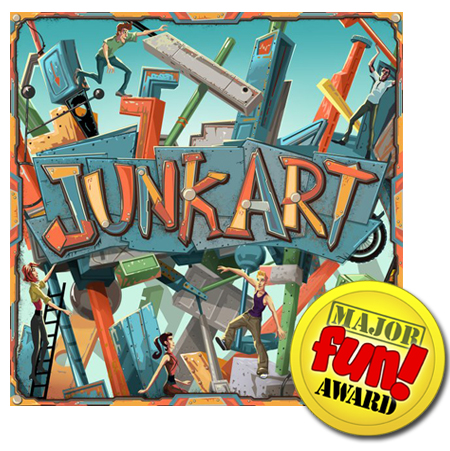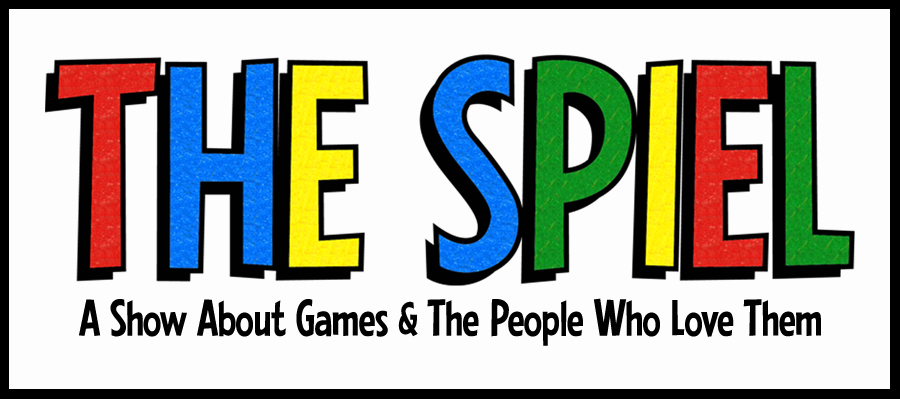Episode 249 - Junk Art is Major Fun

|
Release Date: December 12, 2016 |
Download: PDF |
||
|
Designer: Jay Cormier, Sen-Foong Lim |
Publisher: Pretzel Games |
||
|
2-6 pl 30 min ages 8+ MSRP $70 |
|
Tweet |
|
Art doesn’t have to hang on a wall or come in a gold frame. You can take random objects and build them into beautiful structures. Individually some people might see these pieces as junk but together because of the WAY you put them together your "junk" is ART !
You and your fellow artists are about to embark on a world tour to showcase your talent. Each city you visit will present new challenges to your creative energies.
Junk Art is a stacking game with fresh twist. It's really a dozen different games in one box. Read on to discover why we think Junk Art is Major Fun!
Written review continues after the break.
Junk Art Pretzel Games | BGG | Amazon

The Concept
Art doesn’t have to hang on a wall or come in a gold frame. You can take random objects and build them into beautiful structures. Individually some people might see these pieces as junk but together because of the WAY you put them together your "junk" is ART !
You and your fellow artists are about to embark on a world tour to showcase your talent and skill and put them to the test, building new beautiful structures in each city you visit. And each city you visit will present new challenges to your creative energies. The player who is able to gather the largest group of fans will walk away known as the best junk artist of his or her time.
The Components
Junk Art comes with a big ol’ box of junk in the form of weird and wonderfully shaped wooden pieces. There are 60 pieces in total, 15 different shapes in four different colors. There are thin pieces, chunky pieces, pieces with holes or slots, round pieces, flat pieces - a veritable banquet of found objects for your creations.



Each player gets a wooden base on which you will build your art.
There are cards for the cities you will visit.

And there are cards representing each wooden piece in the game.

There are tokens representing the fans you gain as you play. Fans = points in the game.
There’s also a mini tape measure you may need to decide whose sculpture is the tallest.
To begin the game, arrange the entire pile of wooden pieces on the table so everyone can reach them. Each player gets a base. Last of all, select three of the city cards for your tour. From there, you’re ready to play !
The Mechanics
Junk Art is a dexterity/stacking game. Each round you’ll create a work of art using cards to determine which pieces you use to create your artwork. Each city card provides a goal and rules for the round.
There are some basic stacking rules that always apply. Each piece must be placed on your base and cannot touch the table. You can use two hands to place it. You cant touch the structure itself BUT you can steady the base with one hand and stack with the other. You can nudge pieces around. And if you drop the piece you’re working on, you can try again as long as the whole structure didn't fall. Any other pieces that fall off during construction, you’ll set aside in a personal pile. Sometimes these pieces may count against you.

At the end of each round, fan tokens will be awarded based on the goals provided by the city. At the end of three rounds, the player with the most fans wins.
What Sets This Game Apart
Junk Art is NOT your typical stacking game because Junk Art is really a dozen different games in one box.
Each time you play you will be playing 3 of the games included. Each city card in the game provides its own set of rules and guidelines that will dictate how you play. You will proceed from city to city to city from left to right, playing and scoring by each city’s rules
Here’s a sample of a few different cities and the challenges you could face:

In Tokyo, each player starts with 10 piece cards. You select one card from these 10 put it on top of the deck and then hand it to the next player. That player flips over the card and must place the piece shown in their work of art. Play continues until all cards are played. The goal is to build the tallest work of art.

In Indianapolis, each player gets 10 piece cards. When someone says go, flip over the top card and add that piece to your artwork. Try to get all the pieces on the cards played to your art as fast as you can. The player with the most pieces added to their artwork scores the most fans

In Paris, players build a common artwork on a single base. Each player has 3 piece cards and chooses one to play, adding that piece to the artwork. Play continues with players drawing and placing pieces until junk starts to fall. The minute you knock off three or more pieces, you’re out for the round. The goal is to not get eliminated.

In New York, you select a piece card from one of three face up cards and place that piece on your base. If the piece you play touches a matching shape or color piece, you have to pick another card and place another piece. When you reach the star cards in the deck, the round ends. The goal is to build the tallest work.
There are cities where you play cards like a mini trick taking game to decide who gets what piece. There are cities where you place all the pieces of a single color. There are cities where you must collaborate on a common work.
As you can see, there is an immense variety in gameplay within even a single game of Junk Art.
Each individual city card, complete with rules and goals could have been packaged as a solo game. In addition, the designers provide three blank cards for players to create their own cities and rules to add to the fun.
The variety and replayability of Junk Art sets it apart from every other dexterity/stacking game on the market by a wide margin!
Final Thoughts
It is worth noting that Junk Art is a beautiful game. The pieces individually are interesting and pleasing to touch and behold. As you build, the odd shapes provide lots of inspiration for new and different combinations. If you’re going to make a game about creating art, the game itself must embrace a certain artfulness and allow the players to find ways to express it. Pretzel Games deserves very high marks for clearly making this a priority in the production and design of the game’s physical components.
At $70, the game isn’t cheap. Given the quality and number of components I think the game provides good value for the price but this price has the potential to be a real barrier to entry. The game is definitely more fun with six players but I am left to wonder if the game might have been better served as a 4 player game simply to reduce the number of components and the price. Junk Art is worth the investment, don’t get me wrong. The game is ridiculously fun! My only fear is that it may not be able to reach a wider audience due to the higher pricetag.
Junk Art defied my expectations in the best possible way. I sat down thinking I knew what I was in for…. another stacking game with some small tweak. There are classics like Jenga, Super Rhino, Bausack and Bamboleo but most others in this category are pale imitiations of these classics. It was a wonderful surprise to discover how designers Jay Cormier and Sen-Foong Lim were able to add such a fresh and different voice to a the stacking genre by mixing in tried and true game mechanics popular in less action based games. Card drafting, trick taking, even semi-cooperative play make Junk Art special but still super easy to teach and play.
Junk Art as an actual art form is all about remixing found objects to make new and beautiful statements and this game puts that lovely idea into practice. Give Junk Art a try at a party or with your family and you’ll see what I mean. And you’ll know why it is most certainly Major Fun.
***

